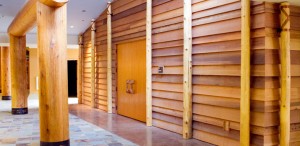Special Introduction from Margaret Riddle —
Decades in the planning, Tulalip’s Hibulb Cultural Center opened on Friday August 19, 2011 to Tribal members and invited guests and to the general public on the 20th and 21st. My husband and I attended on Saturday with Snohomish County Museum Director Barbara George and, simply said, the museum is really impressive—very modern in display concept and the spaciousness of the interior made me feel as though I was in a natural setting. Even the entrance walkway appears to be a stream.
Entering the main museum space, we were greeted with bays that told the stories of two friends: cedar and salmon. Both displays were very moving. Continuing on, we read about glacial retreat, the land bridge, archaeology and Indian whaling. Then we were reminded of the sad story of the Point Elliott Treaty, the loss of a way of life and the tragedy of the Indian Boarding School, where, in Harriette Shelton Dover Williams’ words, the day consisted mostly of “Marching, Marching, Marching.” All of the displays include Lushootseed text.
Walking through the museum I had a strong sense of the spirit and history of the Tulalip Tribes, clearly told in their own words. Literally so since oral history audio and video accompany many of the displays. Best perhaps with “Warriors: We Remember,” an exhibit that honors men and women who participated in our country’s various wars. I linger here for some time, watching video oral histories—personal stories of tribal warriors who served, interspersed with actual war footage. On the walls nearby were the oval portraits of many who served as well as portraits of Gold Star women, mothers of World War I dead.
At the end of the main hallway is a cedar longhouse which is built into the museum. You can watch a video about the history of the longhouse and the role it has played in the lives of the Coast Salish. I was continually drawn to the fine craftsmanship of the structure, the smell of the cedar and the art of the story poles. Throughout the museum there are works of contemporary artists in the building itself, story poles, carvings and art-stenciled window etchings.
The Tulalips have dreamed of this place for many years and Director Hank Gobin and his staff (Melissa Parr, Inez Bill, Joy Lacey, Jaedean Jess, Lita Sheldon Mowrer, Tessa Campbell, Richard Young and Gene Enick) has worked to make it happen but it only became a reality when the Tribes gave $19 million to build the 23,000 square foot cultural center, a 10,000 square foot collections wing, and a 42 acre natural history preserve. This is an important place. The Tulalips have not only built a great museum but a gathering place with classrooms and meeting space where they can share their knowledge and stories with one another, a place where they can rediscover their traditions and share them with their children and all of us. For info about visiting see
http://www.hibulbculturalcenter.org/
